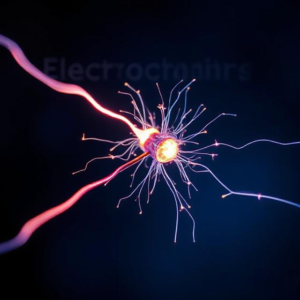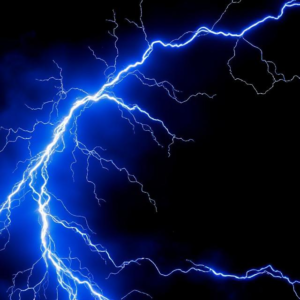What is Electricity?
Electricity is a form of energy that flows through conductors (like wires) to power devices such as lights, computers, and appliances. You can think of electricity as the flow of tiny particles (called electrons) through a material.

Key Concepts of Electricity
There are a few fundamental concepts that help us understand how electricity works:
- Atoms and Electrons: Everything around us is made of atoms, which are made up of smaller particles like protons, neutrons, and electrons. Electrons are the negatively charged particles that move when electricity flows.
- Voltage (V): Voltage, also known as electric potential difference, is the force that pushes electrons through a conductor (like a wire). Think of it as the pressure in a water pipe that pushes water through the pipe. Voltage is measured in volts (V).
- Current (I): Electric current is the flow of electrons through a conductor. It’s like the flow of water through a pipe. The higher the current, the more electrons are moving. Current is measured in amperes (A) or amps (A).
- Resistance (R): Resistance is the opposition to the flow of current. It’s like friction in a water pipe that slows down the water flow. Materials like copper have low resistance (good conductors), while materials like rubber have high resistance (good insulators). Resistance is measured in ohms (Ω).
- Power (P): Power is the rate at which electrical energy is used or produced. In simple terms, it’s how much work electricity can do in a given amount of time. Power is measured in watts (W).The formula to calculate power is:
So, if you know the voltage and current, you can calculate the power.
How Electricity Flows
Electricity flows in a closed loop or circuit. A circuit is a path that allows current to flow. There are two main types of circuits:
- Series Circuit: In a series circuit, components (like light bulbs) are connected in a single path. If one component fails, the entire circuit is broken, and everything stops working.
- Parallel Circuit: In a parallel circuit, components are connected in multiple paths. If one component fails, the other components will still work.
Types of Electricity
There are two main types of electricity: Static Electricity and Current Electricity.
- Static Electricity: Static electricity happens when there is an imbalance of charges on the surface of objects. For example, when you rub a balloon on your hair, it gains extra electrons, creating a negative charge. This charge can jump to a nearby object (like a doorknob) and create a spark. Static electricity is the reason why you sometimes get shocked when touching metal objects.
- Current Electricity: This is the electricity that flows through wires and powers electrical devices. Current electricity can be either alternating current (AC) or direct current (DC).
- AC (Alternating Current): In AC, the direction of the current constantly changes. This is the type of electricity that comes from most power outlets and is used in homes and businesses.
- DC (Direct Current): In DC, the current flows in one direction only. This type of electricity is used in batteries and devices like flashlights and phones.
Understanding Circuits
A basic electric circuit includes several key components:
- Power Source: The power source provides the electrical energy. This can be a battery (DC) or a power outlet (AC).
- Conductors (Wires): Conductors, usually made of copper or aluminum, are the pathways through which electricity flows.
- Load: The load is any device that uses electricity, like a light bulb, fan, or phone charger.
- Switch: A switch controls whether the electricity flows in the circuit or not. When you turn off a light, you’re opening the circuit by turning off the switch.
Important Electrical Terms
- Circuit Breaker: A safety device that automatically turns off the circuit if there’s too much current, preventing damage or fire.
- Fuse: Similar to a circuit breaker, but it works by melting when the current is too high, stopping the flow of electricity.
- Insulator: Materials like rubber, plastic, or wood that don’t allow electricity to pass through. They protect us from electric shocks by covering wires.
- Conductor: Materials like copper or aluminum that allow electricity to flow easily through them.
How is Electricity Generated?
Electricity can be generated in several ways, most commonly:
- Burning Fossil Fuels (coal, oil, natural gas): These are burned to create steam that turns a turbine, which generates electricity.
- Nuclear Power: Nuclear reactions create heat to generate steam that powers a turbine.
- Renewable Sources: Solar panels, wind turbines, and hydroelectric dams generate electricity from natural sources like sunlight, wind, and flowing water.
- Hydropower: The force of falling or flowing water is used to turn turbines that generate electricity.
Why is Electricity Important?
Electricity is essential for our daily lives. It powers everything from our homes to industries. Here are some of its uses:
- Lighting: Without electricity, we wouldn’t have streetlights, lamps, or any kind of artificial lighting.
- Communication: Phones, televisions, computers, and the internet all rely on electricity.
- Transportation: Electric cars, trains, and public transportation systems rely on electricity.
- Manufacturing: Factories use electricity to run machines and produce goods.
Safety with Electricity
Electricity is powerful, so it’s important to use it safely:
- Never touch exposed wires: Always assume wires are live (carrying electricity), and avoid contact.
- Use properly rated electrical devices: Make sure your appliances are rated for the correct voltage and current.
- Turn off electrical devices when not in use: This helps prevent accidents and saves energy.
- Install circuit breakers: These safety devices protect against electrical overloads and prevent fires.
Summary
- Electricity is the flow of electrons through conductors (like wires).
- It has three key components: Voltage (pressure), Current (flow), and Resistance (opposition to flow).
- Current electricity flows in a circuit and can be either AC (alternating current) or DC (direct current).
- Power is the rate at which electricity does work, and it’s calculated using the formula: Power = Voltage × Current.
- Circuits are the pathways that allow electricity to flow and do work, like lighting a bulb or running a motor.
- Safety is important when dealing with electricity to prevent shocks and accidents.
Electricity is a crucial part of modern life, and understanding its basics can help you stay safe and appreciate how it powers the world around us!











